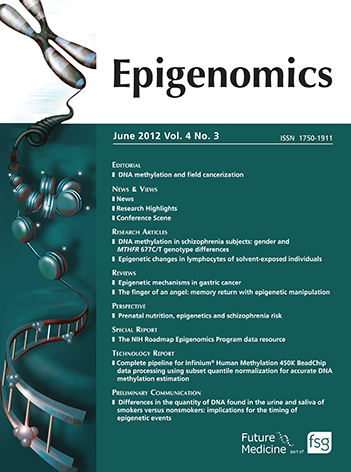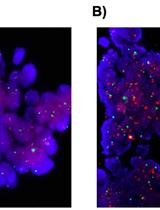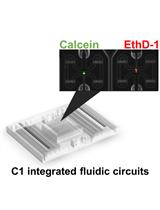- EN - English
- CN - 中文
Enhanced-ice-COLD-PCR for the Sensitive Detection of Rare DNA Methylation Patterns in Liquid Biopsies
Enhanced-ice-COLD-PCR用于液体活检中罕见DNA甲基化模式的敏感检测
发布: 2019年12月05日第9卷第23期 DOI: 10.21769/BioProtoc.3452 浏览次数: 6215
评审: Nicoletta CordaniMarija MojicAnonymous reviewer(s)
Abstract
In the context of precision medicine, the identification of novel biomarkers for the diagnosis of disease, prognosis, predicting treatment outcome and monitoring of treatment success is of great importance. The analysis of methylated circulating-cell free DNA provides great promise to complement or replace genetic markers for these applications, but is associated with substantial challenges. This is particularly true for the detection of rare methylated DNA molecules in a limited amount of sample such as tumor released hypermethylated molecules in the background of DNA fragments from normal cells, especially lymphocytes.
Technologies for the sensitive detection of DNA methylation have been developed to enrich specifically methylated DNA or unmethylated DNA using among other methods: enzymatic digestion, methylation-specific PCR (often combined with TaqMan like oligonucleotide probes (MethyLight)) and co-amplification at lower denaturation temperature PCR (COLD-PCR).
E-ice-COLD-PCR (Enhanced-improved and complete enrichment-COLD-PCR) is a sensitive method that takes advantage of a Locked Nucleic Acid (LNA)-containing oligonucleotide probe to block specifically unmethylated CpG sites allowing the strong enrichment of low-abundant methylated CpG sites from a limited quantity of input. E-ice-COLD-PCRs are performed on bisulfite-converted DNA followed by Pyrosequencing analysis. The quantification of the initially present DNA methylation level is obtained using calibration curves of methylated and unmethylated DNA. The E-ice-COLD-PCR reactions can be multiplexed, allowing the analysis and quantification of the DNA methylation level of several target genes. In contrast to the above-mentioned assays, E-ice-COLD-PCR will also perform in the presence of frequently occurring heterogeneous DNA methylation patterns at the target sites. The presented protocol describes the development of an E-ice-COLD-PCR assay including assay design, optimization of E-ice-COLD-PCR conditions including annealing temperature, critical temperature and concentration of LNA blocker probe followed by Pyrosequencing analysis.
Background
In the context of precision medicine, the discovery of novel non-invasive biomarkers in clinical samples such as circulating cell-free DNA (ccfDNA) is crucial for improving the diagnosis, prognosis, predicting and monitoring the response to a patient-tailored treatment regimen against cancer and other diseases (Siravegna et al., 2017, Wan et al., 2017; Cabel et al., 2018; Barlebo Ahlborn and Østrup, 2019). The analysis of ccfDNA is challenging because the outcome depends on multiple pre-analytical steps and requires the development of methods for the detection of genetic and epigenetic variations that are present in limited quantity in highly fragmented samples (Lewis et al., 2015; Kumar et al., 2018).
Especially, methylated ccfDNA could be a promising non-invasive biomarker for cancer and potentially other diseases (Lehmann-Werman et al., 2016; Warton et al., 2016). In comparison to mutations and other genetic changes, DNA methylation changes occur early during carcinogenesis and are also present in a number of other complex non-neoplastic human diseases. Furthermore, DNA methylation changes are often restricted to a genomic region of limited size, for example the promoter associated CpG island or the transcription start site in contrast to genetic mutations that might be present all along the gene. The most commonly used methods for the analysis of DNA methylation patterns are based on a bisulfite reaction that converts cytosine bases into uracil bases while 5-methylcytosine bases are not converted (Frommer et al., 1992). Bisulfite conversion thus translates a DNA methylation difference into a sequence change. DNA methylation patterns are then read-out using next generation sequencing or microarrays for genome-wide analysis or Pyrosequencing, methylation-sensitive or methylation-specific PCR (MSP) methods for locus-specific analysis (Tost, 2016).
Different DNA methylation enrichment approaches for the analysis of low DNA methylation levels have been developed based on digestion or oligonucleotide probes (Liu et al., 2017; Campan et al., 2018; Distler, 2019). For example, the HeavyMethyl method which is based on enrichment of methylated DNA by blocker probes competing with the amplification primers on the target site, is used for a commercially available non-invasive blood based test (Molnár et al., 2015; Jung et al., 2018).
While MSP and MethyLight will specifically amplify methylated molecules in the presence of a 1,000 to 10,000 fold excess of unmethylated molecules, the efficient amplification relies on a pre-defined consistent methylation profile underlying the bindings sites for the amplification primers and the hydrolysis probe (for MethyLight), usually completely methylated molecules (Candiloro et al., 2011). However, in the presence of heterogeneous DNA methylation patterns, the assays fail to amplify partially methylated molecules and significantly underestimate the proportion of methylated samples (Alnaes et al., 2015).
Co-amplification at lower denaturation temperature PCR (COLD-PCR) approaches have been developed to enrich and analyze rare mutations including full, fast, ice (improved and complete enrichment), E-ice (Enhanced-ice) and temperature tolerant COLD-PCR and have been combined with several read-out technologies (Mauger et al., 2017). These protocols use a critical temperature (Tc) to selectively denature wild-type mutant heteroduplexes to allow the enrichment of rare mutations. More recently, fast-COLD-MS-PCR and E-ice-COLD-PCR, have been shown to allow the enrichment of unmethylated DNA and methylated DNA, respectively, from bisulfite-converted DNA (Castellanos-Rizaldos et al., 2014; Mauger et al., 2018).
E-ice-COLD-PCR uses a blocker probe that contains several LNA bases which selectively hybridizes to and thereby blocks the amplification of wild-type alleles and enriches mutant alleles followed by a Pyrosequencing assay for a sequence based read-out at single nucleotide resolution (How-Kit and Tost, 2015). For DNA methylation analysis, LNA blocker probes are designed to block unmethylated CpG sites on bisulfite-converted DNA enriching thus all other DNA methylation patterns except for completely unmethylated molecules (Mauger et al., 2018).
Therefore, the design of E-ice-COLD-PCR assays is fundamentally different from the more widely used MSP assays as it impedes the amplification of the normal, unmethylated state, but does not make any requirements on the degree or the patterns of DNA methylation in the amplified target region. All molecules different from the blocked pattern will be amplified and the subsequent sequencing-based analysis gives detailed information on the molecules that have been enriched. E-ice-COLD-PCR reaction can be easily multiplexed and the level of mutations or DNA methylation can be quantified using standard curves for the analysis of very low input material such as ccfDNA (Mauger et al., 2016 and 2018; Sefrioui et al., 2017).
The current protocol describes the development and implementation of an E-ice-COLD-PCR assay for the enrichment of low-abundant methylated DNA from a limited quantity of input sample and thus applicable to non-invasive blood-based tests. After bisulfite conversion, the E-ice-COLD-PCR reaction is performed followed by Pyrosequencing analysis. The optimization of E-ice-COLD-PCR includes assay design, optimization of the reaction and analysis of the amplification product.
While the presented protocol focusses on the technically more demanding detection of hypermethylation, blocker probes could also be used to block methylated DNA and enable the enrichment of unmethylated DNA in the presence of an excess of methylated DNA.
Materials and Reagents
- DNA LoBind and PCR Tubes 2 ml (Eppendorf, catalog number: 022431048) or similar
- LightCycler® 480 Mutiwell Plate 96, white (Roche, catalog number: 04729692001)
- LightCycler® 480 Sealing Foil (Roche, catalog number: 04729757001)
- Pyrosequencing plate (PyroMark® Gold Q96 Plate, Qiagen, catalog number: 979101)
- PyroMark® Q96 HS Capillary Tips (Qiagen, catalog number: 979104)
- PyroMark® Q96 HS Reagents Tips (Qiagen, catalog number: 979102)
- PCR Plate 96-well (Thermo Fisher, catalog number: AB0800) or similar
- Adhesive PCR Plate (Thermo Fisher, catalog number: AB0558) or similar
- Polyethylene adhesive PCR Plate (Corning, catalog number: 6524) or similar
- Aluminium Adhesive PCR Plate (Corning, catalog number: 6569) or similar
- 10/20 µl filter tips (Rainin, catalog number: 17002429) or similar
- 200/250 µl filter tips (Rainin, catalog number: 17002428) or similar
- 1,000 µl filter tips (Rainin, catalog number: 17002426) or similar
- 10 µl tips (Rainin, catalog number: 17005091) or similar
- 250 µl tips (Rainin, catalog number: 17005093) or similar
- 1,000 µl tips (Rainin, catalog number:17005089) or similar
- EpiTect control DNA methylated (Qiagen, catalog number: 59655)
- Unmethylated and methylated DNA standards (Zymo Research, catalog number: D5014)
- Qubit dsDNA HS Assay (Thermo Fisher, catalog number: Q33226)
- Epitect Fast DNA bisulfite kit (Qiagen, catalog number:59826)
- EZ DNA Methylation-Gold kit (Zymo Research, catalog number: D5005) or similar
- Primers, blocker probes and Pyrosequencing primers, HPLC-purified grade (TIBMOLBIOL)
- Nuclease Free water (Invitrogen, catalog number: AM9937)
- HotStar Taq Polymerase (provided with the respective HotStar Taq buffer, Qiagen, catalog number: 203203)
- UltraPureTM Agarose (Thermo Fisher, catalog number 16500500)
- dNTP Mix (Thermo Fisher, catalog number: R0192)
- SYTOTM 9 Green Fluorescent Nucleic Acid Stain (Thermo Fisher, catalog number: S34854)
- PyroMark® Gold SQA Q96 Reagents (Qiagen, catalog number: 972812)
- Streptavidin Sepharose beads (GE Healthcare, catalog number: 17-5113-01)
- Denaturing Buffer (0.2 M NaOH)
- 70% Ethanol
- MgCl2
- Tris-HCl
- Tris base
- NaCl
- EDTA
- Tween-20
- Acetic acid
- Binding Buffer (see Recipes)
- Annealing Buffer (see Recipes)
- Wash Buffer (see Recipes)
Equipment
- A pre-PCR room with Laminar flow cabinets and a post-PCR room
- 20, 200 and 1,000 µl and multichannel pipettes (Rainin) or similar and filter tips in pre-PCR room
- Vortex for tubes
- Centrifuge for plates and microtubes (Eppendorf) or similar
- Refrigerant block for 96 plates and ice bucket
- Qubit Fluorometer (Thermo Fisher) or similar
- QIAcube (Qiagen) or similar
- LightCycler® 480 Instrument (Roche LifeScience) or similar
- LightCycler® 96 Instrument (Roche LifeScience) or similar
- Thermocycler (Eppendorf) or similar
- Thermomixer (Eppendorf) or similar
- PyroMark Q96 Vacuum Workstation (Qiagen, catalog number: 9001529)
- Pyrosequencer (PyroMark Q96 MD System, Qiagen) or similar
Software
- Design of PCR primers using MethPrimer (http://www.urogene.org/methprimer/) (Li and Dahiya, 2002)
- Nucleic Acid Sequence Massager (http://www.attotron.com/cybertory/analysis/ seqMassager.htm)
- Design of Pyrosequencing primers can be performed manually or using the commercial PyroMark assay design software (Qiagen)
- Manual design of LNA blocker probe and calculation of Tc using the LNA oligo Tm prediction tool (http://www.exiqon.com/ls/homeoflna/Oligo-tools/tm-prediction-tool.htm)
- LightCycler 480 Software (Roche LifeScience) or similar
- Gradient LightCycler 96 Software (Roche LifeScience) or similar
- PyroMark® CpG Software (Qiagen) or similar
- Statistical or graphical software such as Excel® or similar
Procedure
文章信息
版权信息
© 2019 The Authors; exclusive licensee Bio-protocol LLC.
如何引用
Mauger, F. and Tost, J. (2019). Enhanced-ice-COLD-PCR for the Sensitive Detection of Rare DNA Methylation Patterns in Liquid Biopsies. Bio-protocol 9(23): e3452. DOI: 10.21769/BioProtoc.3452.
分类
癌症生物学 > 基因组不稳定性及突变 > 遗传学
癌症生物学 > 通用技术 > 遗传学 > 基因表达
分子生物学 > DNA > DNA 合成
您对这篇实验方法有问题吗?
在此处发布您的问题,我们将邀请本文作者来回答。同时,我们会将您的问题发布到Bio-protocol Exchange,以便寻求社区成员的帮助。
提问指南
+ 问题描述
写下详细的问题描述,包括所有有助于他人回答您问题的信息(例如实验过程、条件和相关图像等)。
Share
Bluesky
X
Copy link













